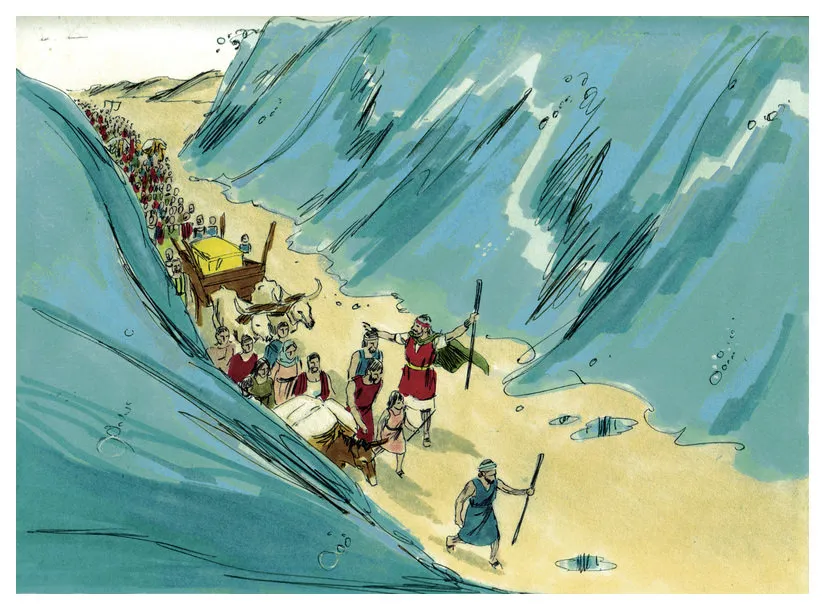The Bible recounts various stories and historical events that have impacted human civilization for thousands of years. Among these stories, the tale of the Persian King Xerxes stands out as a fascinating account of ancient rulers and their place in biblical history. Who was Xerxes, and what was his role in the Persian Empire and the Bible? In this blog post, we explore the story of Xerxes and unravel his place in history, providing readers with a compelling glimpse into the world of biblical and ancient history. Read on to learn more about this intriguing figure and his impact on the world.
The Story of Xerxes in the Bible

Xerxes is a historical figure who is mentioned in the Old Testament of the Bible. He was one of the most powerful monarchs of Persia and played a significant role in ancient history. In this section, we will unravel the story of Xerxes in the Bible and explore his place in biblical history.
Who Was Xerxes?
Xerxes was the son of Darius I and Atossa, making him a member of the Achaemenid dynasty, which ruled over Persia from 550 to 330 BCE. He became the king of Persia in 486 BCE after his father’s death.

Xerxes in the Persian Empire and History
Xerxes is best known for his invasion of Greece, which was a significant event in ancient history. However, despite his military exploits, he is also remembered for his monuments, such as the construction of the massive Gate of All Nations.
Xerxes and His Role in Biblical History
One of the most notable accounts of Xerxes in the Bible is found in the book of Esther. This biblical narrative tells the story of a young Jewish queen named Esther who was married to Xerxes, also known as Ahasuerus. The book of Esther is a fascinating tale of how Esther saved the Jewish people from the evil plot of the villainous Haman.
The Book of Esther and Xerxes’ Reign
In the book of Esther, Xerxes is shown to be a powerful monarch who rules over a vast empire, including the land of Israel. He is depicted as a king who enjoys lavish feasts and seeks the company of beautiful women. In the opening scene of the book of Esther, Queen Vashti refuses to appear before Xerxes and is subsequently banished for her disobedience. This sets the stage for Esther to become queen and eventually save her people from destruction.
Xerxes’ Place in the Bible and Historical Records
While the book of Esther is the most well-known reference to Xerxes in the Bible, he is also mentioned in other biblical accounts. For example, the book of Ezra also includes references to Xerxes and his reign. Additionally, Xerxes is an important figure in the history of Israel and plays a significant role in the Persian invasion of Judah.
In conclusion, Xerxes was an important historical figure who played a significant role in both Persian history and biblical history. While the accounts of his reign in the Bible are brief, they provide a fascinating glimpse into the royal courts and ancient rulers of the ancient civilizations.
Who Was Xerxes?
Xerxes was a historical figure and a king of the Persian Empire who lived during the fifth century BC. He is famously known for his role in the Greco-Persian Wars and for his appearance in the Bible.
Xerxes was a member of the Achaemenid dynasty, which ruled over the Persian Empire during its height and was known for its efficient administration and military conquests. Xerxes’ father was Darius I, who was the king of Persia before Xerxes.
Upon his ascension to the throne in 486 BC, Xerxes spent the next several years consolidating his power and preparing for military campaigns. He successfully invaded Greece in 480 BC with a massive army, but ultimately suffered a defeat at the Battle of Salamis.
While Xerxes is known for his military campaigns, he also made significant contributions to the arts and architecture. He famously commissioned the construction of the Gate of All Nations and the Palace of Persepolis, which are still standing today and attest to the wealth and grandeur of the Persian Empire.

In the Jewish culture, Xerxes is better known as Ahasuerus, the king mentioned in the Book of Esther. The book tells the story of Queen Vashti’s refusal to obey Xerxes’ command and her subsequent dethronement. Xerxes then holds a beauty pageant to find his new queen, which leads to Esther’s selection. Esther ultimately saves the Jewish people from genocide planned by the grand vizier, Haman.
Xerxes’ role in the Bible is debated among scholars, as his actions are at times portrayed as positive and at other times as negative. Some see him as a benevolent ruler who ultimately supported the Jewish people, while others see him as a tyrant who was easily influenced by his advisors.
Despite the debate surrounding Xerxes’ portrayal in the Bible, he remains an important figure in both biblical and ancient history. His contributions to architecture, his military campaigns, and his presence in the biblical narrative all make him a significant character in understanding the ancient world.
Xerxes in the Persian Empire and History
Xerxes was not only a significant figure in the Bible, but he also played an important role in Persian history. He was the son of King Darius I and ascended the throne after his father’s death in 486 BC.
During his reign, Xerxes continued the territorial expansion of the Persian Empire initiated by his father, conquering many territories from Libya to India. However, the most significant event that occurred during his reign was the invasion of Greece in 480 BC. This invasion is famously known as the Battle of Thermopylae, where the Spartans and their allies held off the Persian army for three days.
Despite the setback at Thermopylae, Xerxes was still able to capture and burn down Athens. However, he faced defeat in the Battle of Salamis, a naval battle fought between the Greek city-states and the Persian Empire. This marked the end of the Persian invasion of Greece.
« Unveiling the Mysteries of Heavenly Hosts
Understanding the Role of a Pastor Emeritus in Church Leadership »
Aside from these significant events, Xerxes was known to be a just and wise ruler, respected by his people. He also contributed to the building of many constructions, including the Palace of Persepolis, one of the grandest buildings in ancient times.
Xerxes’ reign was not without controversies, as seen in his treatment of his wives. He famously banished his first wife, Queen Vashti, after she refused to appear before him at a banquet. His marriage to Esther, the Jewish queen, also sparked debate as to whether he genuinely loved her or only married her for political purposes.
Despite these controversies, Xerxes still remained a dominant figure in Persian history. His reign ended with his assassination in 465 BC, leaving behind a legacy of a great ruler who contributed to the expansion of his empire and the building of many grand constructions that are still standing today.
Key takeaways:
- Xerxes was the son of King Darius I and continued his father’s territorial expansion.
- His invasion of Greece in 480 BC is famously known as the Battle of Thermopylae and the Battle of Salamis.
- He was a respected and just ruler who contributed to the building of many grand constructions.
- Xerxes’ treatment of his wives, including his banishment of Queen Vashti and marriage to Queen Esther, sparked controversy but did not diminish his contribution to Persian history.
- Xerxes’ reign ended with his assassination in 465 BC.

In summary, understanding Xerxes’ role in Persian history is crucial in fully comprehending his place in the Bible. As an ancient ruler, Xerxes left a mark in history that is still felt and celebrated today.
Xerxes and His Role in Biblical History
Xerxes, also known as Ahasuerus, was a prominent figure in both ancient history and the Bible. As the king of Persia during the fifth century BC, Xerxes’ story is intertwined with the ancient empires and the history of Israel.
In the Old Testament, Xerxes is first mentioned in the book of Ezra, where he is noted as the son of Darius the Great. Xerxes succeeded his father as King of Persia and reigned from 486-465 BC. During his reign, Xerxes became known for his campaigns against Greece, including the famous Battle of Thermopylae.
However, Xerxes’ most significant role in the Bible is depicted in the book of Esther. The story of Esther recounts the rise of Esther and her successful attempts to save the Jews from extermination. Xerxes plays a key role in the story as the king who selects Esther as his queen and is ultimately convinced by her to save the Jewish people.
Xerxes’ reign as king is also significant in the Bible, as it marked the beginning of the end of the Babylonian captivity. Xerxes’ decree allowed the Israelites to return home and begin rebuilding the temple in Jerusalem.

In Jewish culture, Xerxes is also known for his queen, Vashti, who refused his orders to appear before him during a royal banquet. This act of disobedience ultimately led to her being replaced by Esther as queen.
Despite his role in biblical history, Xerxes’ reign was not without its challenges. His campaigns against Greece were ultimately unsuccessful, and he was assassinated in 465 BC.
Overall, Xerxes’ story serves as a reminder of the significant role that ancient rulers played in shaping the course of history. His place in the Bible and historical records has cemented his legacy as a prominent figure in both ancient civilizations and biblical accounts.
The Book of Esther and Xerxes’ Reign
When it comes to the story of Xerxes in the Bible, the Book of Esther plays a crucial role in understanding his reign and legacy. In this biblical account, Xerxes is known as Ahasuerus, the King of Persia.

At the beginning of the book, Ahasuerus throws a lavish six-month feast for his subjects, displaying his great wealth and power to the world. During the feast, his queen, Vashti, refuses to come before him and showcase her beauty, resulting in her banishment from the royal court.
This event leads to a search for a new queen, which ultimately leads to Esther, a Jewish woman who rises to the position of queen and uses her influence to save her people from an evil plot against them.
Xerxes’ role in the Book of Esther showcases his place in the Bible as a powerful king with a significant impact on Jewish culture and history. His relationship with Esther illustrates the importance of favor and loyalty in the royal courts of ancient empires.
Some scholars also believe that Xerxes’ invasion of Greece, and his subsequent defeat at the Battle of Salamis, is referenced in the book of Ezra in the Old Testament. This further emphasizes the importance of Xerxes in the context of ancient history and his impact on the world as a whole.
In summary, the Book of Esther provides a unique perspective on Xerxes’ reign and his relationship with the Jewish people. It showcases his role as a powerful monarch within the Persian Empire and highlights the importance of his actions in biblical history.

Here are some key takeaways:
- Xerxes is known as Ahasuerus in the Book of Esther.
- Esther, a Jewish woman, rises to the position of queen under Xerxes’ reign and saves her people from an evil plot.
- Xerxes’ invasion of Greece and defeat at the Battle of Salamis is potentially referenced in the book of Ezra.
- Xerxes plays a significant role in the history of ancient civilizations and is an important character in the Bible’s narrative.
Xerxes’ Place in the Bible and Historical Records
Xerxes, also known as Ahasuerus, is a significant historical figure in both the Bible and ancient history. He was the King of Persia, ruling over one of the greatest empires in the world. Xerxes’ reign was marked by incredible conquests, including the invasion of Greece.
In the Bible, Xerxes is most well-known for his appearance in the book of Esther. The book tells the story of a Jewish woman named Esther who becomes queen to Xerxes. The book details the plot by the evil Haman to exterminate the Jews but thanks to Esther’s bravery and quick thinking the plan is foiled. Throughout the biblical narrative, Xerxes is depicted as a powerful and influential leader.
The Book of Ezra also mentions Xerxes when recounting the rebuilding of the Temple in Jerusalem. The King sends the Jews home with gifts and orders the rebuilding process to begin, showing a sign of support for Jewish culture and religion.
Xerxes’ influence on biblical history is of particular interest because he lived during a crucial time in Jewish history. The Persian Empire traditionally supported religious diversity and promoted tolerance, making them crucial allies to the Jewish people. This support allowed the Jews to return to their homeland and rebuild their temple after being exiled in Babylon.

Xerxes’ place in ancient history also cannot be overlooked. He ushered in a new era of Persian rule, one marked by wealth and power. His tactical and strategic prowess led to many notable victories, including conquering the famous Egyptian city of Memphis. His reign also saw the construction of grand architectural wonders, including the famous city of Persepolis.
In conclusion, Xerxes’ influence on the Bible and history is undeniable. Whether viewed through a religious or historical lens, he was a powerful and influential figure. His place in the Persian Empire and his interactions with the Jewish people played a crucial role in shaping the trajectory of biblical history. Xerxes serves as a reminder of the impact even the most ancient rulers can have on the world today.












